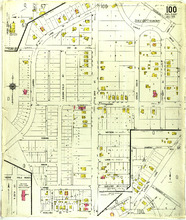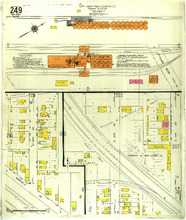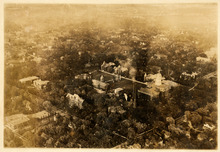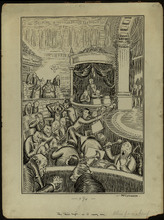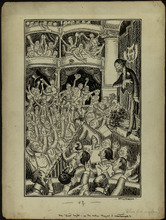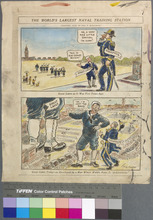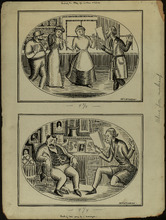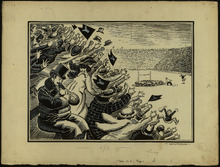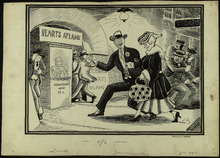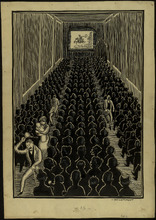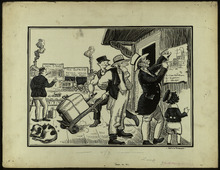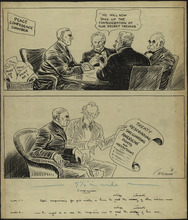1910 - An early look at Rothwell Gymnasium
Rothwell looks a lot more expansive that it did a hundred years ago, but the 1910 gymnasium did have a lot of facilities. The complex had a 4-person track, an aquatic center, an outdoor gym, a trophy room, and more. While the modern Student Rec Center holds a lot more amenities, the original Rothwell was one of the most advanced gyms in the Midwest at the time.
Member of
St. Joseph, Missouri, 1919 May, sheet 100
St. Joseph, Missouri, May 1919. Streets: Circle Drive, Marion, Watson, Long, Oakland Avenue, Highland Avenue, Moss, Breen, Forsee, 6th (Sixth) Avenue, Lovers Lane, N. 26th (Sixth) Street, Gene Field Road, Eugene Field Avenue, N. Noyes Avenue, Union Avenue, N. 22nd (Second) Street, Circle Drive, Goff Avenue, Woodbur
Aerial view of UMC's White (East) Campus, 1919
Aerial view of UMC's White (East) Campus, 1919. The University's White Campus appears minus several accustomed structures, only a bare patch of ground marks the spot where Green Memorial Chapel and the Memorial Union and Tower now stand.
Aerial view of UMC's Red (West) Campus, 1919.
Aerial photograph of Red Campus. In this photograph, UMC's Red (West) Campus is a mixture of the familiar and the seemingly out of place. Well-known buildings, such as Jesse and Switzler Halls share the space with long-vanished structures such as the old power plant (just west of Jesse Hall) and Lathrop Hall (on 6th street where Engineering East is now located).
JM-C002: The first night as it really was
Editorial cartoon depicts the same theater as seen in C-001. But this time, half of the seats are empty, and many of the people are yawning or checking the time.
JM-C001: The first night as the author thought it would be
Editorial cartoon depicting a man bowing to a crowd. The crowd is giving a standing ovation and seems very excited.
JM-W003: The world's largest naval training station
Editorial cartoon depicting two panels, one from five years ago and one from contemporary time. In the first panel, Annapolis is shown looking down at the Great Lakes review, which only consists of a few soldiers and onlookers. In the second panel, the Great Lakes figure completely overshadows the Annapolis figure, and the field is full of soldiers, military vehicles, and civilians.
JM-C003: Reading the play to a home audience vs. reading his play to a [manager]
Editorial cartoon depicting the play author reading his play to his family, who clap for him with large smiles on their faces. In the next panel, the smiling man reads his play to a man surrounded by portraits who slouches in his chair without any sign of enthusiasm.
JM-C005: The Sisters of Ruth speeding to help distress signal
Editorial cartoon depicting six women seated in a car labeled "Sisters of Ruth" and laden with packages and flowers driving down a country road. In the distance, an S.O.S. flag is seen sticking into the air near the top of a house.
JM-C007: Cheering crowd at a football game
Editorial cartoon depicting the crowd at a football game. All of the audience members are cheering or waving flags, except for one man who is seen working on his nails.
JM-C009: Couple going to the theater for "Hearts Aflame"
Editorial cartoon depicting a man and woman walking together toward a movie theater, where others are already entering. The advertised movie is "Hearts Aflame". Men in shadows stare at the couple heading toward the theater. The movie title might refer to the 1917 film "Love Aflame", which was also known as "Hearts Aflame".
JM-C004: A full house for the Western movie at the theater
Editorial cartoon depicting the inside of a movie theater. A man on a horse firing a gun can be seen on the screen, and the seats are all filled.
JM-C010: The changing world: Books that caused fear now and then
Editorial cartoon consisting of two scenes. In the first scene, a Victorian woman is recoils from a "Ouida" book presented to her by a man. In the second scene, a woman in 1920s attire shows a sweating man a book titled "Sex Problem". "Ouida" was the pseudonym of the English novelist Maria Louise Ramé, who was known for her literary salon and the scandalous books she published toward the beginning of her career.
JM-C008: Scene at a railroad station with main street in the background
Editorial cartoon depicting men and a boy standing on the platform of a railroad station watching a man draw a diagram of a ship. Behind the station platform, a line of shops on main street are visible.
JM-177: Winning the war
The cartoon depicts the personified Germany crawling his way across Europe during WWI, representing Germany's military advances during the war. The top left panel is captioned, "words won't win the war". This meant words could not be used to cause the German surrender. The top right panel is captioned, "wishes won't win the war". The panel shows Americans watching Germany from across the Atlantic, wishing the German people would overthrow Kaiser Wilhelm II. The middle-left panel shows those same Americans shouting in outrage at the Germans over American deaths from the war. The panel is captioned, "wrath won't win the war". The middle-right panel shows Americans displaying the vast wealth available for a war effort. The panel is captioned, "wealth won't the war". The bottom panel shows the Germans finally being stopped after being hit with the butt of a gun. The panel is captioned, "But wallops will win the war!". This cartoon suggests aggressive force was the only way for the United States to defeat Germany in WWI. This cartoon was created in 1917, and the US official participation in WWI was from 1916-1917. (Summary created by Mary Delano, MU History Intern, Spring 2018)
JM-182: The new income tax
This cartoon depicts a man being irritated with the high income tax rates in the United States. The man suggests the reason for the increased taxes is the fact the the United States is currently fighting in World War I. The man continues to complain about the income tax until he passes a group of soldiers. The man realizes his financial sacrifice is less than that being made by the men serving in the military. (Summary created by Mary Delano, MU History Intern, Spring 2018)
JM-189: Compromises
The top panel of this cartoon depicts President Woodrow Wilson meeting with other world leaders at the Paris Peace Conference in 1919. The Paris Peace Conference began after the armistice agreement for World War I, and it eventually produced the Treaty of Versailles. The four men meeting depict the leaders of the "Big Four" Allied powers of WWI. The Big Four nations were the United States, led by President Woodrow Wilson, England, led by Prime Minister David Lloyd, France, led by Prime Minister Georges Clemenceau, and Italy, led by Prime Minister Vittorio Orlando. These men are creating secret treaties, which is in contradiction with Wilson's "14 Points" speech. The first point in this speech is "Open covenants of peace, openly arrived at, after which there shall be no private international understandings of any kind but diplomacy shall proceed always frankly and in the public view". This point was created to address the practice of secret treaties between nations, which many contributed to the beginning of World War I. The 14 points are conspicuously placed in the garbage at this meeting. The bottom panel depicts Uncle Sam showing Woodrow Wilson ways to protect the United States while signing treaties with other nations. This panel is captioned, "he ought to be able to compromise now to satisfy the interests of his own". This caption is used to suggest there may have been conflict between President Wilson's interests and the interests of the United States. (Summary created by Mary Delano, MU History Intern, Spring 2018)


